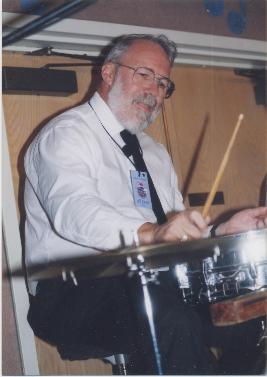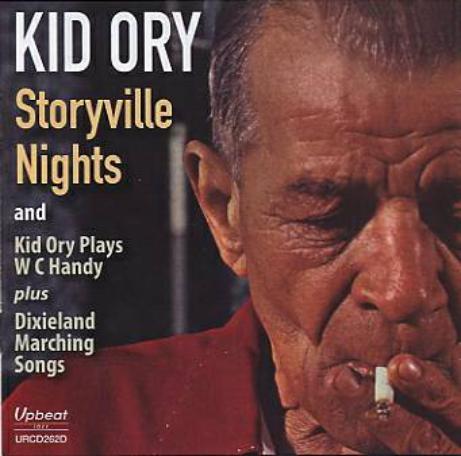KID ORY—“STORYVILLE NIGHTS” (Upbeat URCD262D). Total playing time: 125
mins. 09 secs.
CD 1 Dixieland Marching Songs
Jambalaya*; Ting-A-Ling*; Do What Ory Say†; Walking with the King*; Gettysburg
March; Bye and Bye*; Battle Hymn of the Republic; It’s a Long Way to Tipperary;
Over the Waves; Paddle Wheel; Lassus’ Trombone; Nobody’s Sweetheart*; San.
Recorded on Dec. 21-22, 1960 in Los Angeles, California
Kid Ory Plays W C [sic]Handy
Joe Turner Blues; ‘Way down South; Yellow Dog Blues; Atlanta Blues; Careless Love.
Recorded on Mar. 31 and Apr. 1, 1959 in San Francisco, California
CD 2 Kid Ory Storyville Nights
Storyville Blues† [see note‡]; Doctor Jazz; Milenburg Joys; Jelly Roll Blues; Winin’
Boy Blues†; Boogaboo; Smoke House Blues; Do You Know What It Means to Miss
New Orleans†.
Recorded on Dec. 5, 1961 in Hollywood, California
Kid Ory Plays W C Handy (Part Two)
Aunt Hagar’s Blues; St. Louis Blues; Harlem Blues; Friendless Blues.
Recorded on Mar. 31 and Apr. 1, 1959 in San Francisco, California
Collective Personnel: Kid Ory, trombone, vocal†; Teddy Buckner, Andy Blakeney,
trumpet; Bob McCracken, Caughey Roberts, clarinet; Lionel Reason, Cedric
Heywood, Bob Van Eps, piano; Frank Haggerty, Johnny St. Cyr, guitar; Morty Corb,
Charles Oden, Bob Boyack, bass; Jesse Sailes, Doc Cenardo, drums; Lionel Reason,
vocal*
As part of their Ory LP reissue series on CD, Upbeat have made available what is the
last of the Ory material on LP—or at least that recorded in the studio—including the
hard-to-find Dixieland Marching Songs. The three sessions included here are all from
the Verve label. (Note: all of the Ory material on Verve was previously reissued by
Mosaic in their Complete Kid Ory Verve Sessions in 1999, but it is long out of print.)
Along with the others in this Upbeat series, the transfers here are first class.
In the period these LP’s were recorded Ory was nearing the end of his career—he
retired from playing some five years or so after Storyville Nights was recorded.
However, his playing on these sessions was still robust, full of the glisses and growls
that were among his trademarks, as these discs evince, and his vocals also tended to
match his muted trombone playing—guttural and low pitched, almost suggesting a
growl. His bands, despite the varying personnel over the years, tended to have a
certain Ory imprint as, from his New Orleans background, he never quite jettisoned
ensemble work although he did provide solo space to his members. Even at the end
of a solo, he frequently cannot resist an ensemble punctuation of the last few bars,
leading into the next solo. His rhythm section, too, is always a solid four-to-the-bar,
not a “boom-chick-boom-chick,” and he favored guitar over banjo and string bass
over tuba, giving a little more depth with a light bottom and adding to the pulse of
the bass and piano.
New Orleans has long been famous for its brass bands, and those of Ory’s lifetime did
not hesitate to adapt any tune to a march rhythm, changing a waltz to 4/4 time (Over
the Waves) or a habanera to a 4/4 time signature (St Louis Blues) or a pop tune to a
march (Nobody’s Sweetheart Now). Not many of the tunes from the LP Dixieland
Marching Songs in the first CD are played as marches—even Gettsysburg March and
Battle Hymn of the Republic which begin in 6/8 time do not stay in it throughout.
They are “swung” in common time. Ory is not trying to “recreate” a small marching
band, and any roll offs, such as those in these two marches, are merely a nod in the
direction of a march introduction or a segue from 6/8 to 4/4 time.
The first CD is filled out with the first half of the Kid Ory Plays W C Handy, the
second half of that LP being used to complete the second CD. Handy, by his own
admission, performed, wrote down, and published many traditional or folk songs
under his name, thus preserving them before they were lost. Occasionally he would
piece together several song fragments to make one song. Others bear a resemblance
to yet other songs that have appeared under other titles. Thus Harlem Blues contains
strains that make one think of Worried Man Blues. All of the other Handy
compositions should be familiar except, perhaps, Joe Turner Blues, Way Down South,
and the afore-mentioned Harlem Blues.
The tracks from Storyville Nights are for me the best on this set—whether fast or slow
they swing. The rhythm section provides that solid base on which the front line can
build, and the front line takes full advantage of it. Blakeney does not go chasing after
notes at the top of the high register, as Buckner does on the other two albums, and
McCracken is quite content to play a spare clarinet line, not indulging in flurries and
cascades of notes as does Roberts. And behind (or below) it all is that pulsating
rhythm section, propelled by Cenardo on drums, who, unlike Sailes, is not wedded to
a backbeat on most numbers and utilizes pressed rolls which, to my ears, enhance the
rhythm. These eight Storyville Nights tracks are, by themselves, worth the price of
admission to this double CD issue.
Traditional jazz fans who don’t have the Mosaic CD set (or, perhaps, the Verve LP’s)
will want to add this pair to the other Ory Upbeats they probably have.
While Upbeat is an English label, this CD can probably be purchased in the U.S. at
Jazzbymail, www.jazzbymail.com, which stocks Upbeat releases, or at the Upbeat
web site, www.upbeatmailorder.co.uk and at the time of writing, Upbeat has a sale
going on—four CD’s for the price of three, including double CD’s.
|
|



